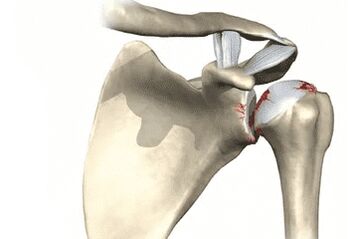
The shoulder joint is one of the most vulnerable in the human skeleton. This is due to the rather complex structure of the joint with weak attachment to the scapula. The shoulder receives a lot of stress every day when performing domestic or professional tasks. If an injury occurs, metabolic processes are disrupted, tissues wear out due to age - dystrophic changes in cartilaginous tissue begin. This pathology is called osteoarthritis of the shoulder joint.
Depending on the manifestations and degree of damage to the glenohumeral joint, four degrees of pathology are diagnosed. There is also a distinction between acute and chronic osteoarthritis of the shoulder. If treatment is not carried out in a timely manner or in bad faith, the joint continues to deform and collapse, which ultimately results in a significant limitation of the functions of the upper limb and loss of mobility.
Today, only grade 1 shoulder arthrosis can be completely cured. But this does not mean that you can give up and do nothing with pathology of grade 2 and higher. Comprehensive and adequate treatment of arthrosis of the shoulder joint with the help of medication or surgery helps to slow down the destruction of the joint, at least partially preserve the mobility of the arm and shoulder, and prevent disability.
Symptoms and causes
Deforming arthrosis of the shoulder joint does not develop in one day. At first the changes are small. Cartilage gradually loses its elasticity under the influence of various factors - these can be age-related changes or disturbances in metabolic processes in tissues. Microcracks appear on its surface, in which calcium salts accumulate. Then it becomes thin, fragile and begins to fall apart.
Often this process is accompanied by inflammation, which also spreads to the surrounding muscle, connective and bone tissues. This manifests mainly as pain - at first mild, aching. They then become more intense and in advanced stages never disappear, which significantly reduces the person's performance and quality of life.
The main reasons why shoulder joint DOA develops are as follows:
- Impaired blood circulation in the cartilaginous tissues of the shoulder in atherosclerosis and other chronic diseases associated with blood vessels.
- Chronic pathologies of an autoimmune nature, for example, rheumatoid arthritis, systemic lupus erythematosus.
- Dysfunction of the endocrine system (diabetes mellitus).
- Congenital anomalies of the shoulder joint, birth injuries in infants and other injuries that lead to pathological deformation and dysfunction of the limb.
- Acquired pathologies of joint structures after injury or accident, unsuccessful surgery, including inflammation due to arthritis, synovitis, osteoporosis, etc.
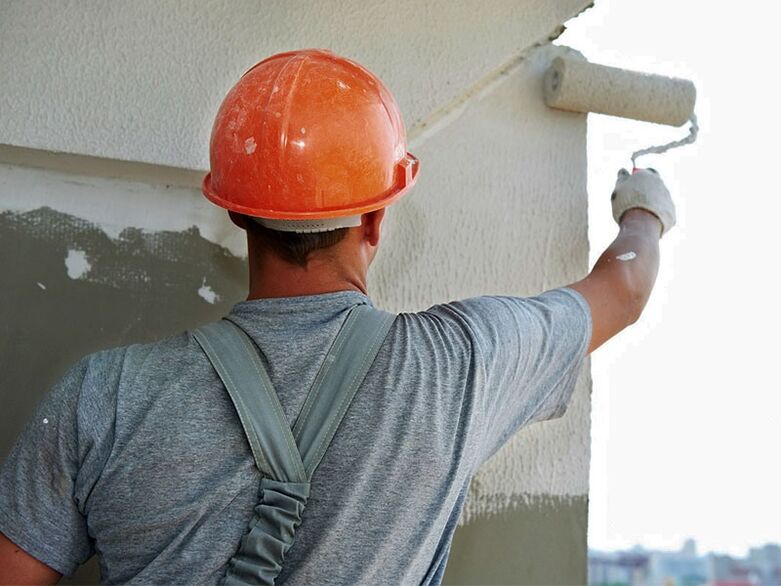
In addition, there are provoking factors, under the influence of which the risk of developing shoulder arthrosis increases several times. These include:
- professional activity in which the shoulder joint receives heavy loads day after day for many years - shoulder arthrosis is rightly called the disease of plasterers, painters and loaders;
- sedentary lifestyle, lack of physical activity - with insufficient exercise, blood circulation slows down, joint tissues do not receive the required amount of nutrients and begin to atrophy;
- excess weight - often combined with the previous factor: with obesity, a person cannot actively move, while the joints receive additional stress due to extra pounds;
- hereditary predisposition;
- old age – approximately 80% of people over 70 years of age experience symptoms of osteoarthritis.
Most often, when examining and interviewing a patient, the doctor identifies a combination of several diseases and provoking factors. A typical patient diagnosed with osteoarthritis of the shoulder joint is a man or woman over 50 years old, involved in heavy physical work, overweight and other chronic pathologies (diabetes mellitus, high blood pressure, varicose veins, knee arthritis, etc. ). In this case, injuries to the right shoulder are more common than the left. This is due to the fact that most people actively use their right hand at work and at home, with the exception of congenital left-handers.
How to recognize the disease
Symptoms of osteoarthritis of the shoulder joint may take a long time to appear. If from time to time the shoulder starts to hurt, the person attributes it to tiredness, takes painkillers, uses an ointment with a warming effect and calms down. But, sooner or later, there comes a time when the pills and ointments no longer help, the pain becomes constant, intense and uncomfortable at rest and at night. In addition to this symptom, the following signs will indicate dystrophic changes in the shoulder joint:
- swelling and deformation of the joint, visible to the naked eye;
- redness of the skin over the joint, local increase in temperature;
- characteristic crisis in the joint. Creaks when the hand moves sharply are explained by the accumulation of salts in the cracks of the cartilage and between the articular elements. At first, the clicking occurs only with sudden movements, it is silent and almost inaudible. In advanced forms of the disease, the shoulder contracts with each movement, the sound is heard by other people;
- limitation of limb mobility. When examining a patient, the doctor will ask him to comb his hair. This test is enough to diagnose osteoarthritis of the shoulder joint: the patient will feel sharp pains, he will make a rotational movement with his shoulder, it will be difficult for him to move his shoulder back, the doctor will hear pops and clicks in the joint.
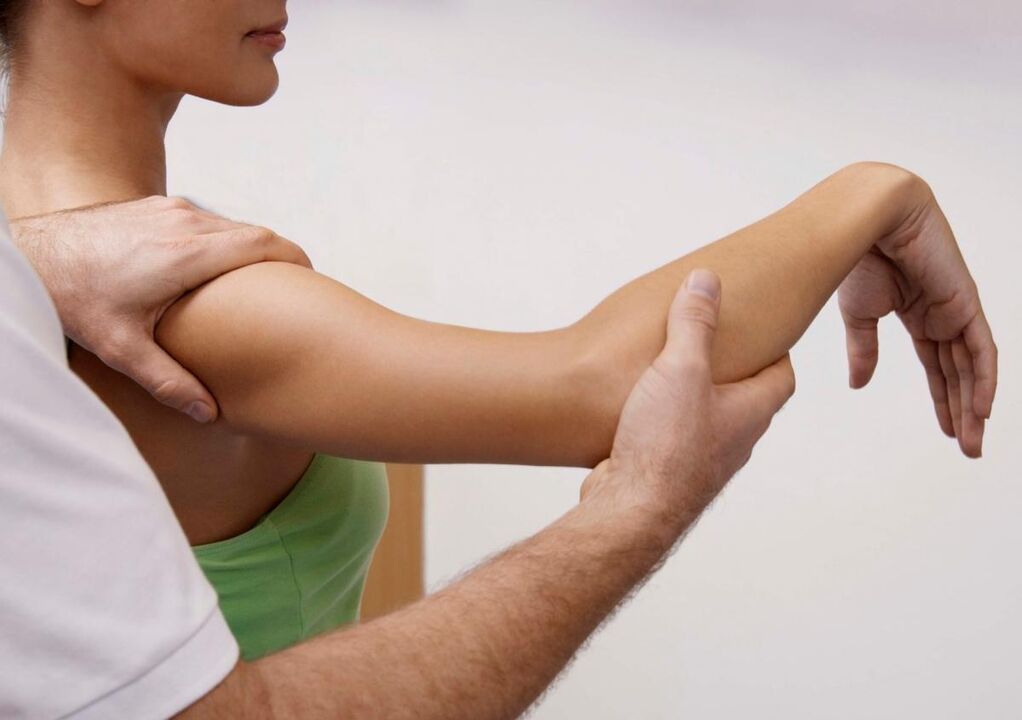
Shoulder DOA must be treated, otherwise over time the patient will lose complete upper limb mobility and performance. If the process of destruction of cartilage and surrounding tissues has already begun, it will not stop on its own. Proper nutrition, folk remedies, a healthy lifestyle and exercise are not enough here. To face the problem and prevent disability, complex treatment with medications of different effects and physical procedures will be necessary.
Degrees
There are several stages of DOA of the shoulder joint, each of them manifests itself differently and requires a different approach to treatment.
- 1st degree.At this stage, the disease is just beginning to develop, changes in cartilaginous tissue are still small. The main symptoms of grade 1 AOD are weakness in the joints and limbs and persistent and periodic pain. Pain occurs after physical exertion, during monotonous and repeated movements of the hands for a long time. After a night's sleep or a long period of rest, a person feels stiffness in the shoulder joint, but as it develops, the stiffness still disappears without medications and physical procedures - a slight warm-up is enough. If you take an x-ray at this stage, the image will not show significant changes in the joint structures, although thinning and deformation of the cartilage may be noted.
- 2nd degree.The pathological process continues and manifests itself more actively. People get used to the fact that after work their shoulder will hurt, they "expect" the pain, they have painkillers and ointments for joint pain, pharmacy or homemade, ready. X-ray diagnostics will show noticeable changes in the joint: thinning and deformation of the cartilage, inflammation of the articular membrane. From time to time, the joint turns red and swells; you may hear pops, creaks, and clicks during movement.
- 3rd degree.The shoulder joint hurts and grinds constantly, to reduce discomfort the person tries not to touch it or move the limb. The deformity is visually noticeable; the affected shoulder differs in size and shape from the healthy one; It often turns red and swells, which is accompanied by increased pain. It is not possible to remove them with painkillers.

If nothing is done in the third stage of the disease, the fourth stage will occur - complete immobility of the shoulder joint and limbs. In this case, it is already useless to prescribe medications and physiotherapy; only endoprosthetic surgery will help to at least partially restore the functionality of the hand. But even this is not always successful.
On a note:In medical practice, it is extremely rare to encounter grade 3 shoulder arthrosis. Typically, the patient seeks medical help earlier and begins treatment. Severe cartilage destruction can occur in the context of extensive trauma, if for some reason the patient cannot see a doctor, or if the person lives in disadvantaged social conditions where qualified doctors are not available.
How is osteoarthritis diagnosed and treated?
A good doctor will be able to make a preliminary diagnosis after a conversation with the patient and his external examination. Instrumental diagnostic methods are more necessary to exclude other pathologies and complications or to identify them. To accurately determine the severity of joint damage and whether inflammation occurs, the following diagnostic measures are carried out:
- radiography;
- Computed tomography;
- Magnetic resonance imaging;
- in some cases, ultrasound to get a complete picture of the state of the joint;
- clinical urine and blood tests - the number of leukocytes and the erythrocyte sedimentation rate will be assessed. If they are too high, an inflammatory process develops in the body.
The best way to treat the pathology is determined by the doctor individually, taking into account the age, occupation and general condition of the patient.
Traditional treatment involves the use of the following methods and means:
- A course of nonsteroidal anti-inflammatory drug therapy. Medicines are prescribed in the form of tablets or powders for oral administration or in the form of ointments for external use to eliminate the main symptoms of inflammation - pain, swelling, redness, increased body temperature.
- Anesthetics for severe pain in the form of tablets or injections. These medications cannot be taken continuously, do not eliminate the cause of the disease and are only intended for extreme cases when the pain is unbearable.
- A course of chondroprotectors - drugs that promote the restoration of cartilaginous tissue and prevent further destruction. They also partially relieve pain and swelling and deformation of the shoulder joint. These medications do not work immediately; they need to be taken for at least 3-4 months.
- A course of muscle relaxants - tablets or injections that relax muscle spasms. They are optional medications in the complex treatment of osteoarthritis and are not always prescribed.
- A course of taking vitamin-mineral complexes and dietary supplements with collagen and hyaluronic acid.
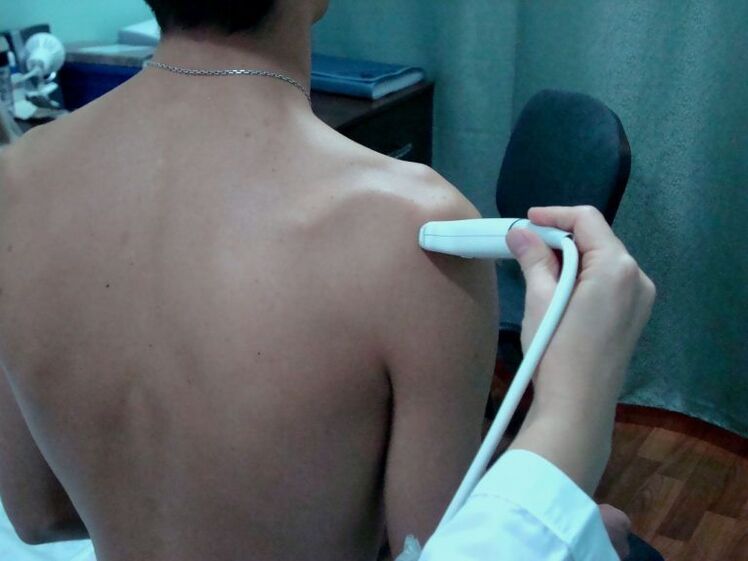
To increase the effectiveness of treatment, speedy recovery and prevention of new injuries, special therapeutic nutrition is also prescribed. The patient's diet includes foods rich in vitamins B, A, C, E - fresh fruits and vegetables, cabbage of any variety, cereals, legumes. Polyunsaturated fatty acids can be obtained from marine fish and seafood. A gelatin diet is practiced, as gelatin helps restore elasticity to cartilaginous tissue. The menu includes gelatinous meats made from ox hooves and tails, formaldehyde and various jellies. It is useful to take pure gelatin, previously soaked in warm water.
Physiotherapy is the next important point in the complex treatment of shoulder osteoarthritis. They are started only when the inflammatory process is stopped. Depending on the degree of the disease, its dynamics and the effectiveness of drug treatment, the doctor selects a combination of the following physical procedures:
- cryotherapy;
- acupuncture;
- electrophoresis;
- laser therapy;
- magnetic therapy;
- mud therapy;
- massages of various types;
- physiotherapy.
Physiotherapy procedures are aimed at activating metabolic processes in joint tissues, normalizing blood circulation and restoring limb mobility. With their help, it is possible to reduce the number of medications taken and their dosage, which is especially valuable if the pathology is observed in a teenager, elderly person or nursing mother.
Useful advice:It is possible to treat grade 1-2 injuries of the shoulder joint at home with the additional use of folk remedies. The main thing is that the patient does not forget to take medications in a timely manner and does not skip physical procedures - the effect will be noticeable and lasting only if all the doctor's prescriptions are followed regularly and conscientiously.
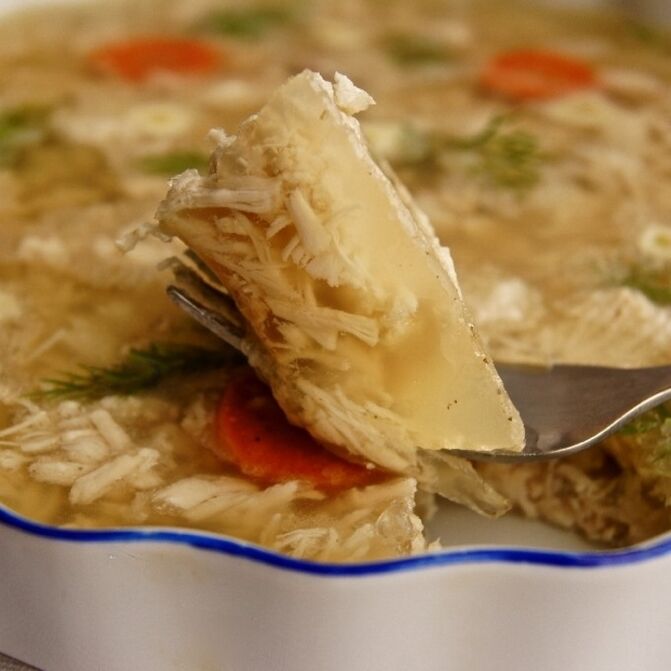
If conservative treatment is ineffective, the doctor is obliged to offer the patient surgery. The remains of the destroyed joint will be removed and a prosthesis will be implanted in its place. Such an intervention is not uncommon, but it requires highly qualified doctors, precision and attention at every stage. Furthermore, prostheses do not always take root well and the recovery period after surgery lasts at least six months. Therefore, if you notice that your shoulder begins to hurt, pull, regularly go numb or hear a crunching noise when moving, do not postpone a doctor's appointment, undergo a timely examination and, if necessary, begin treatment.
Osteoarthritis of the shoulder joint is a very common pathology of the musculoskeletal system, occurring mainly in people over 50 years of age. The pathology develops gradually, little by little, under the influence of unfavorable factors, the joint structures begin to collapse, which is manifested by pain, swelling and joint stiffness. In the early stages, the progression of the disease can be stopped with the help of complex treatment: medications, vitamin supplements, diet therapy and physiotherapy. Advanced osteoarthritis can only be treated surgically.































